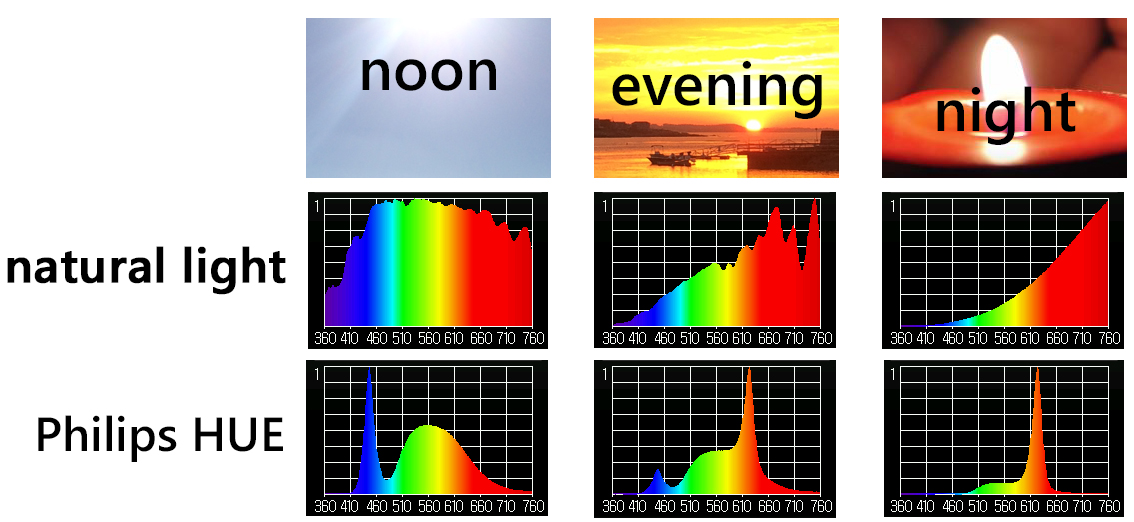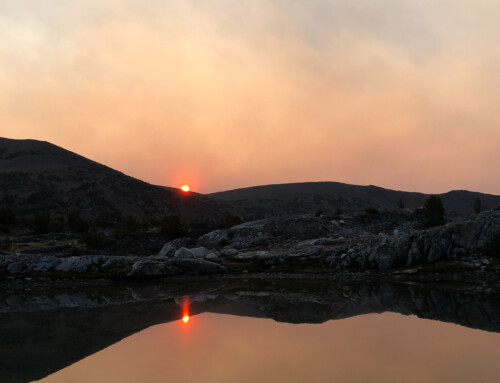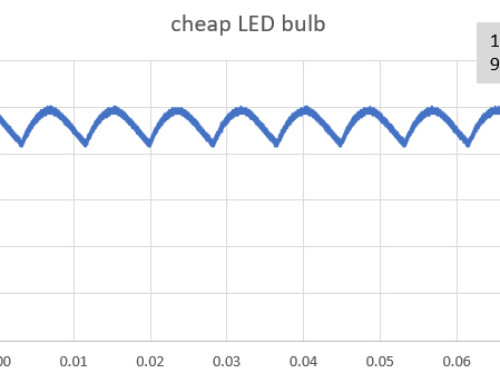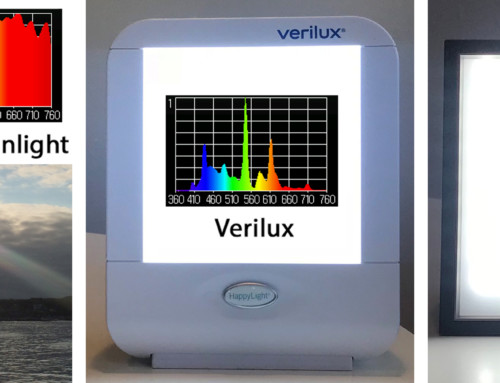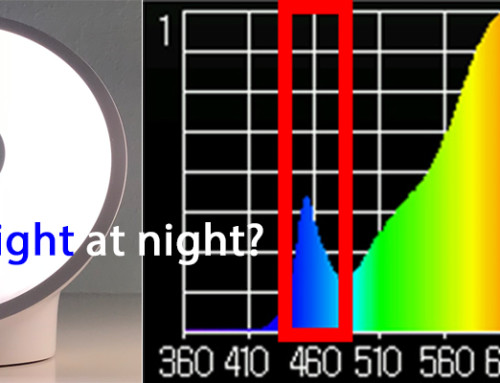Philips deserves a lot of credit for their Philips Hue = educating the world that light is about more than on/off/dim. While the Philips Hue is the leading color-changing ‘smart bulb’, it is optimized for entertainment and not for delivering the benefits of natural light. The Hue is great for syncing light and color to music, and changing your daughter’s room to blue to match the Frozen theme. Unfortunately the Philips Hue falls well short of delivering the health and aesthetic benefits of natural light, and requires quite a bit of fussing to set-up and use. Our Sunlight Inside products are optimized to deliver beautiful, healthy natural light right out of the box. See below for more on how the Philips Hue compares to natural light and to our Sunlight Inside products.
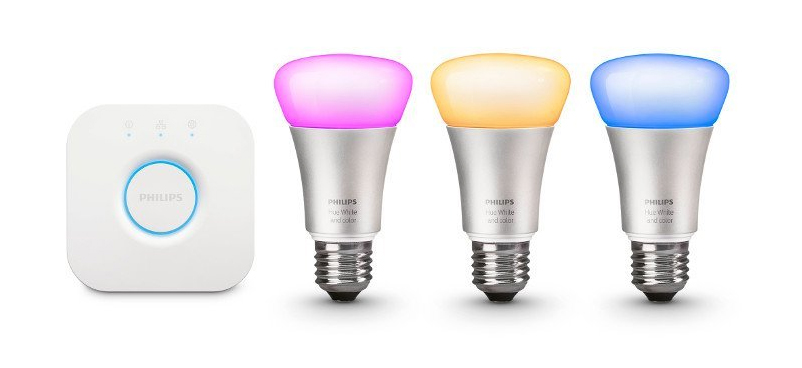
comparing the Philips Hue to natural light and Sunlight Inside:
(a) Natural light contains all the colors of the rainbow, and the ratio of these colors changes with the time of day. During the day natural light is bright and blue (signaling awake and alert), and in the evening natural light is warm and soft (signaling it’s time to relax and sleep). The Philips Hue only offers control over three colors and does not provide sufficient light – severely limiting its ability deliver the health benefits of natural light. Sunlight Inside products provide full control over the light spectrum (6 colors vs. 3 colors), deliver much more light (almost 2x the lumens), and deliver light closer to your eye (for maximum biological impact).
(b) Natural light is beautiful because it contains a natural balance of all the colors of the rainbow – this is why we look and see our best with natural light! The Philips Hue is a 3-color product with significant gaps in the spectrum, so while it can change color, the Hue can never deliver a naturally balanced spectrum. By mixing six colors, Sunlight Inside provides beautiful naturally balanced full spectrum light (see the spectral comparison below).
(c) Natural light changes automatically with the time of day with no wifi or smartphone connection required! The Philips Hue requires installing/configuring a ‘bridge’, then requires using a smartphone for control (and/or custom switches), and relies on regular software updates to keep it working. Furthermore the Philips Hue has no on-board clock which means it starts out cold-white after any power cycle (the worst possible light in the middle of the night), and like other ‘smart-bulbs’ the Philips Hue doesn’t work with traditional dimmers. We’ve designed Sunlight Inside products to deliver natural light automatically (no smartphone or wifi required). Our products work like a regular lamps = just plug them in and turn it on – you get the perfect light at any time of day or night!
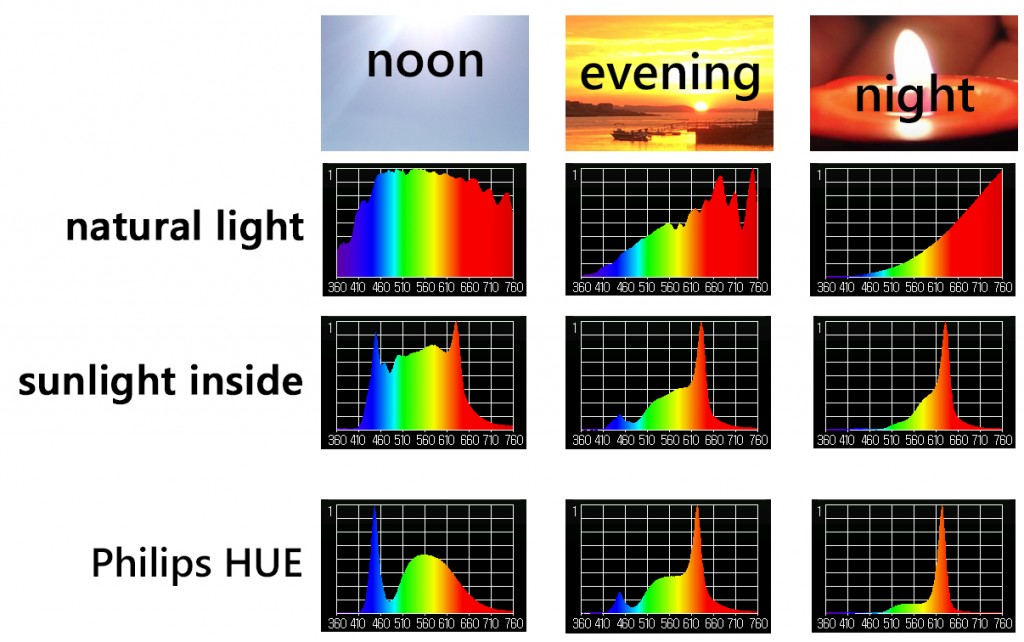
The Philips Hue is able to change color with the time of day, and can provide a first-order approximation of natural light, but with several significant limitations.
(1) The Philips Hue cannot by itself automatically provide the right light at the right time of day. A Philips Hue bulb has no internal clock, so whenever you turn it off and on it reverts to a bright cold white color. This means that if you turn on your bedside or bathroom light at night you’ll be greeted by the harsh glare of a cool-white LED (signaling your body to be awake and alert!?). The Philips Hue relies on an active smartphone or internet connection to know the time of day and what color/intensity of light to provide.
(2) Due to design and thermal limitations, the Philips Hue does not provide enough light during the day to stimulate a biological response, and does not provide enough light at night to read by. During the day the Philips Hue only provides 600 lumens of light at full power, less than a conventional 60W bulb. At night the Philips Hue can provide light without the bio-active blue (safe to use at night), but only a very dim light – enough to see your way to the bathroom but not enough to read or work by.
(3) The Philips Hue cannot provide a naturally balanced light spectrum. The biggest difference between the Philips Hue and natural light is in the daylight spectra, where the Hue delivers too much blue, no cyan, and not enough red to look/feel like real sunlight. The Hue does reasonably well in the ‘sunset’ (warm-white) condition, but then falls a short again on candle-light (with no amber). Mixing 3 colors is just not enough to provide natural light. Keep in mind that the human eye response is peaked in the green, which is why these spectra ‘neglect’ the deep blue (purple) and the far-red, not to mention the need to avoid UV (eye & skin damage) and IR (heat). Net-net the Hue is fundamentally limited by mixing only three colors of light.
The Philips Hue does the best of any ‘smart bulb’ on the market that we’ve tested (great underlying LED technology), but mixing three colors just can’t provide the benefits of natural light. Controlling three colors is less expensive and easier (deterministic solution space). For their professional/commercial products, Philips does offer more sophisticated solutions with spectral control tailored for health benefits (see for example Philips HealWell).

